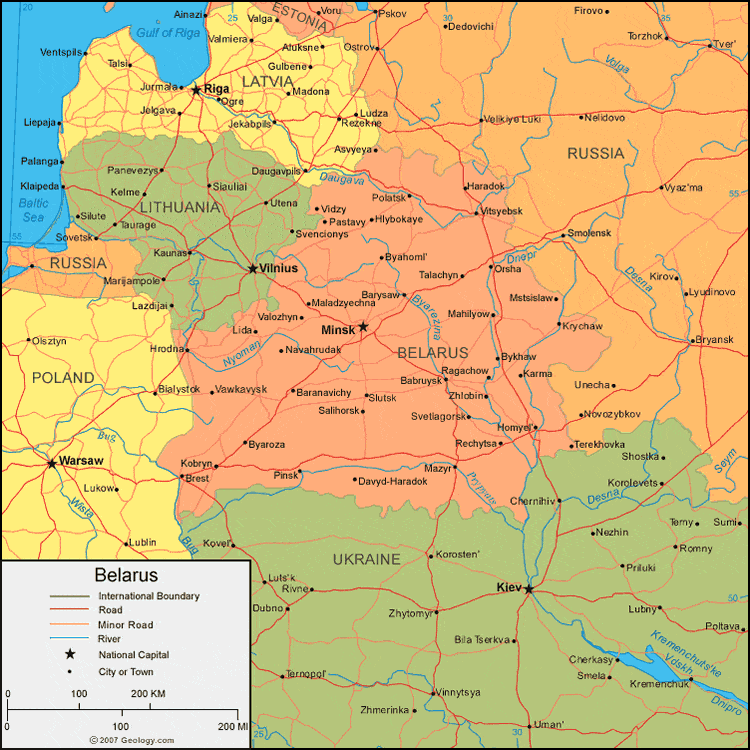I've mentioned the long shadow of history along the current Polish and Ukraine and Belarus borders.
The example I used was the fact you could append the word 'massacre' to just about any city along those borders and have a search term that would result in multiple hits.*
But that was just referring to the 20th century stuff. In today's link the Russian interviewee is talking about the Commonwealth of 300 - 400 years ago as if it were yesterday and the Belarusian interviewer is right with him, and so I'm sure are the Belarusian audience.
Ditto for Poles and Lithuanians.
First though, a map we used a couple weeks before the Russian invasion:
The Polish Commonwealth in 1635 in red:
note: trying to figure-out where Kiev and Smolensk are on this map to double-check this isn't post-the-1667 Treaty of Andrusovo. I think we're good.
And from the Belarusian Telegraph Agency (BelTA), official state media, July 8:
Opinion: Ukraine's future will resemble Partition of Rzeczpospolita
MINSK, 8 July (BelTA) – The future of Ukraine will look like the Partition of the Polish–Lithuanian Commonwealth (Rzeczpospolita), Russian political expert Semyon Uralov told the On Point online project on BelTA's YouTube channel.
“I think this crisis will drag on for decades, it will have an entry point and an exit point. The acute phase began in 2014 and lasted for eight years. It will be followed by another phase that will also last around eight years. Most likely it will look like the Partition of the Polish–Lithuanian Commonwealth. In other words, Ukraine will lose territories one by one. I worked in more than 20 regions of Ukraine, one way or another. Ukraine is very diverse. I would divide it into at least eight different sub-regions. They are all very different and each of them will have their own destiny. There is one large sub-region, let's call it South-East - Left Bank, Novorosia. There are three more sub-regions there. These are Slobozhanshchina in the center with Kharkov and Donbass. There is the Black Sea region. One way or another, this area will either join Russia or fall into the zone of influence of Russia. This is what we see in Zaporozhye and Kherson Oblast,” he said.
Another region is the Dnieper region. “Its territory encompasses the Krivoy Rog iron ore basin, with most of Ukraine's natural resources. The people of Kolomoisky have entrenched themselves there and it is located partly on the right bank, partly on the left. I think it will turn into a big gray zone, because geography will determine everything there. The first geographical barrier is, of course, the Dnieper River. The future of the Dnieper River is being decided now. And the next geographical border is the Carpathians,” the political scientist noted.
According to him, Western Ukraine consists of 4 sub-regions: Volyn, Galicia, Transcarpathia and Bukovina. “They are very different from each other,” he stressed. “Volyn, I think, will somehow lean towards Belarus. I don't want to make predictions, it's wrong, but in terms of the mentality and the way of life people of Polesie and Volyn tend to be closer to Belarus. Hungary will somehow play a role in Transcarpathia. I am sure about it. There are a lot of ethnic Hungarians there and they have their own history of relations. Bukovina is strongly influenced by Romania and Moldova. Galicia is different. It is the ideological center of Bandera ideology. Though it has recently changed a lot. Nothing has russified the Galicia region as much as the current crisis. A great number of people from the Russian-speaking Kharkov, Dnepropetrovsk have fled there. Therefore I expect inter-ethnic tensions there. There will be a very serious social conflict between those who came from the Russian-speaking east and local residents. Fingers crossed, things would not escalate to pogroms."....
My first thought on seeing the children behind the young men trying to force the border was "Why don't the Poles just entrain the people—some say they are Kurds, I have a bit more sympathy for them than for Syrians making the same move—and get them to the German border which is their stated destination.
But there are a couple problems with that idea. 1) Brussels says absolutely not. and 2) The optics of putting masses of people on trains in that part of the world are not so good. If you look at the map of the towns and cities within, say 200 km of the border, from the north Hrodna (Grodno); Bialystok; Brest; Sobibor; Lviv; Lublin:

You can add the word "massacre" to each name and get a multi-hit search result of mainly WWII, but also 1906, atrocities.
Sobibor
was the site of the Nazi extermination camp of the same name, it is
located at the intersection of the current Belarus, Ukraine and Polish
borders
Lublin was the site of another Nazi mass-murder factory/concentration camp, Majdanek as well as the location of the two-day "Harvest Festival" (Erntefest) operation, November 3 - 4, 1943 when some 43,000 people were shot to death.
So no trains, even though they would be heading West.
It is up to the EU, Belarus and Russia to find a solution, the Poles just happen to be in the way.